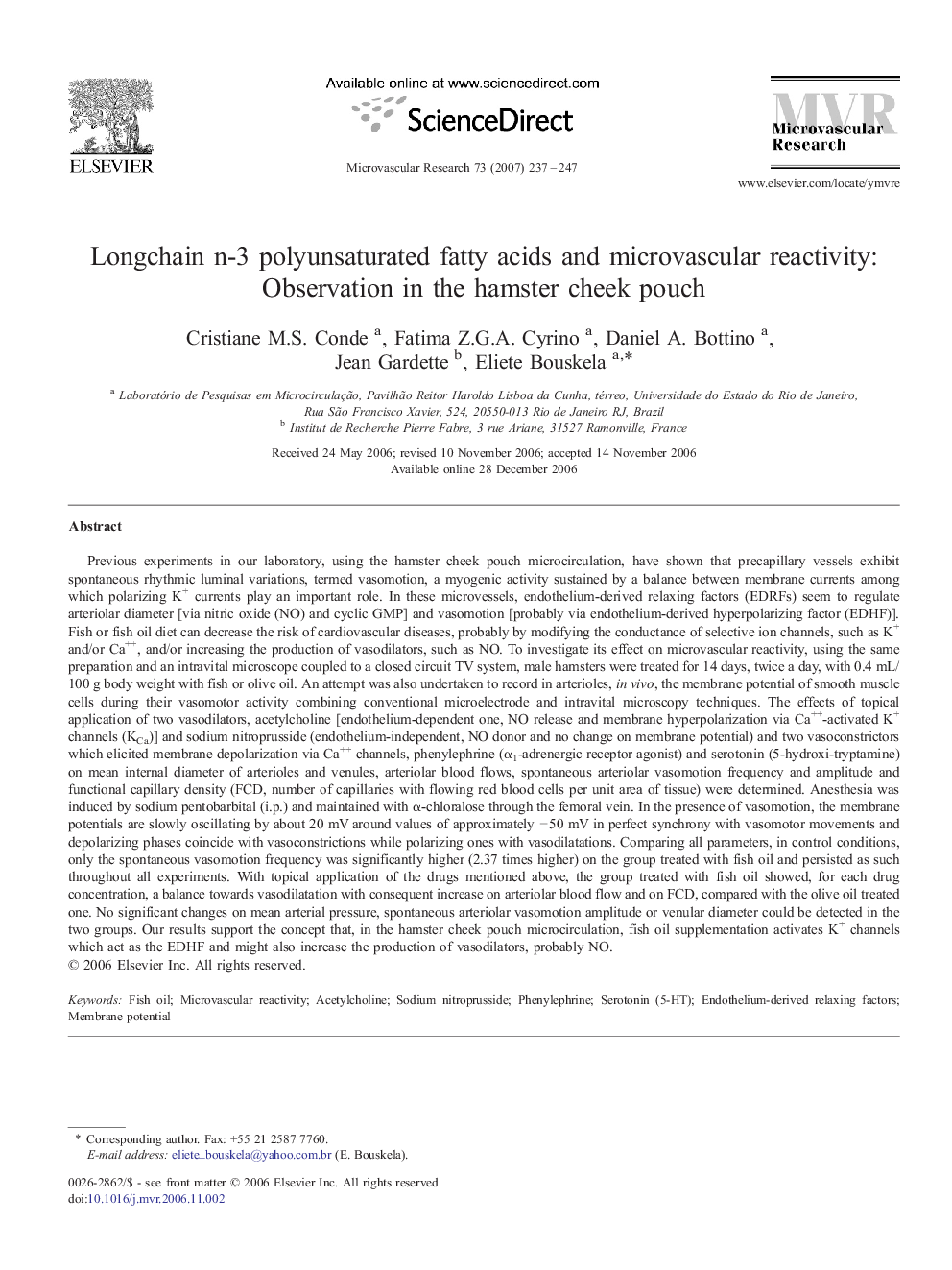| کد مقاله | کد نشریه | سال انتشار | مقاله انگلیسی | نسخه تمام متن |
|---|---|---|---|---|
| 1995505 | 1064977 | 2007 | 11 صفحه PDF | دانلود رایگان |

Previous experiments in our laboratory, using the hamster cheek pouch microcirculation, have shown that precapillary vessels exhibit spontaneous rhythmic luminal variations, termed vasomotion, a myogenic activity sustained by a balance between membrane currents among which polarizing K+ currents play an important role. In these microvessels, endothelium-derived relaxing factors (EDRFs) seem to regulate arteriolar diameter [via nitric oxide (NO) and cyclic GMP] and vasomotion [probably via endothelium-derived hyperpolarizing factor (EDHF)]. Fish or fish oil diet can decrease the risk of cardiovascular diseases, probably by modifying the conductance of selective ion channels, such as K+ and/or Ca++, and/or increasing the production of vasodilators, such as NO. To investigate its effect on microvascular reactivity, using the same preparation and an intravital microscope coupled to a closed circuit TV system, male hamsters were treated for 14 days, twice a day, with 0.4 mL/100 g body weight with fish or olive oil. An attempt was also undertaken to record in arterioles, in vivo, the membrane potential of smooth muscle cells during their vasomotor activity combining conventional microelectrode and intravital microscopy techniques. The effects of topical application of two vasodilators, acetylcholine [endothelium-dependent one, NO release and membrane hyperpolarization via Ca++-activated K+ channels (KCa)] and sodium nitroprusside (endothelium-independent, NO donor and no change on membrane potential) and two vasoconstrictors which elicited membrane depolarization via Ca++ channels, phenylephrine (α1-adrenergic receptor agonist) and serotonin (5-hydroxi-tryptamine) on mean internal diameter of arterioles and venules, arteriolar blood flows, spontaneous arteriolar vasomotion frequency and amplitude and functional capillary density (FCD, number of capillaries with flowing red blood cells per unit area of tissue) were determined. Anesthesia was induced by sodium pentobarbital (i.p.) and maintained with α-chloralose through the femoral vein. In the presence of vasomotion, the membrane potentials are slowly oscillating by about 20 mV around values of approximately − 50 mV in perfect synchrony with vasomotor movements and depolarizing phases coincide with vasoconstrictions while polarizing ones with vasodilatations. Comparing all parameters, in control conditions, only the spontaneous vasomotion frequency was significantly higher (2.37 times higher) on the group treated with fish oil and persisted as such throughout all experiments. With topical application of the drugs mentioned above, the group treated with fish oil showed, for each drug concentration, a balance towards vasodilatation with consequent increase on arteriolar blood flow and on FCD, compared with the olive oil treated one. No significant changes on mean arterial pressure, spontaneous arteriolar vasomotion amplitude or venular diameter could be detected in the two groups. Our results support the concept that, in the hamster cheek pouch microcirculation, fish oil supplementation activates K+ channels which act as the EDHF and might also increase the production of vasodilators, probably NO.
Journal: Microvascular Research - Volume 73, Issue 3, May 2007, Pages 237–247